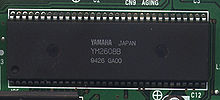Yamaha YM2608

The YM2608, a.k.a. OPNA, is a sound chip developed by Yamaha. It is a member of Yamaha's OPN family of FM synthesis chips, and is the successor to the YM2203. It was notably used in NEC's PC-8801/PC-9801 series computers.
The YM2608 consists of four internal modules:
- FM Sound Source, a six-channel FM synthesis sound system, based on the YM2203
- SSG Sound Source, a complete internal implementation of the Yamaha YM2149/SSG, a variant of the popular AY-3-8910/PSG for producing three channels of square wave synthesis or noise.
- ADPCM Sound Source, a single channel for samples in 4-bit ADPCM format at a sampling rate between 2–55 kHz
- Rhythm Sound Source, a six-channel ADPCM system, enabling playback of six percussion "rhythm tones" from a built-in ROM
The chip includes six concurrent FM channels, four operators per channel, with dual interrupt timers and an LFO. It also includes eight possible operator interconnections, or algorithms, for producing different types of instrument sounds. The SSG (or Software-controlled Sound Generator) is Yamaha's YM2149 programmable sound generator. It includes the SSG's three sound channels, noise generator and dual 8-bit GPIO ports. The YM2608 is used with a YM3016 stereo DAC.
The YM2608 was the basis for the YM2610, most notably used in SNK's Neo-Geo arcade and home console, while the YM2612, most notably used in Sega's Mega Drive (Genesis) console and Fujitsu's FM Towns computers, was similar to the YM2608 in terms of its features and functionality, leading to many referring to the YM2608 as being the basis for the YM2612. However, the YM2612 was mostly based on the YM2608's predecessor, the YM2203.[1]
The YMF288, a.k.a. OPN3, is a later development of the YM2608, used in later NEC PC-9801 computer sound cards. It removes the YM2608's GPIO ports, CSM (Composite sine mode) and the ADPCM Sound Source. It also reduces the wait times on register access, and adds a low-power standby mode. The YMF288 also came in much smaller physical 28-pin SOP and 64-pin QFP packages.
